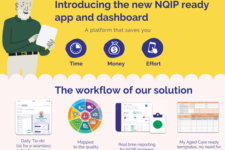
They’re the ones who build trusted relationships with customers – who communicate with them every day, pick up on unspoken cues, receive immediate feedback and notice common issues that arise.
Too often, though, these valuable insights go unnoticed. Many traditional feedback programs treat the customer and employer as separate channels, focussing solely on the voice of the customer and their experience (VoC) or the voice of the employee and their satisfaction levels (VoE).
What’s missing is the informed perspective of employees who are actually with customers as they are experiencing services. Frontline staff have direct contact with customers, whether in residential aged care facilities, out in the community, or in the home environment. This direct relationship is not only rich with insight, but pivotal to shaping an organisation’s culture.
By keeping VoC and VoE in silos, organisations aren’t able to access ‘on the ground’ feedback about the care they provide. They also miss an opportunity to support staff members, and empower them to provide a better customer experience.
The value of VoCE
The care sector is now starting to recognise the importance of both the voice of the customer and employee, with VoC and VoE programs becoming far more integrated than ever before.
A new perspective – the voice of the customer through the employee (VoCE) – is emerging: a practical method that seeks feedback from frontline employees regarding key elements of the customer experience.
We’re already seeing that combining VoC and VoE into a new program has two clear benefits for aged care organisations.
Benefit #1: better customer insight
Employees offer a view into customer experience that organisations may not be able to get from feedback forms alone. By asking team members what they think will make customers happier, organisations gain knowledge about how people really feel about their care.
Employees are also able to recognise patterns in customer experience, such as issues that continually arise over time, certain themes that emerge from feedback, and whether there are common pain points in service provision.
This can help organisations understand which underlying processes are failing, and act to resolve issues faster.
Benefit #2: more engaged staff
Studies reveal organisations that actively engaged employees lead to 233 percent higher customer loyalty rates. Furthermore, employees that feel their voice is heard are 4.6 times more likely to feel empowered to do their best work.
The connection is clear: motivated and engaged team members are in a better position to provide care that customers are happy with.
A strong VoCE program is a powerful way to show employees that you’re listening to them and supporting them. If they are involved in the implementation of better customer service, they will feel like they hold the power to drive real change and build a better caring culture.
VoCE and the Happy Life Index
As leaders in customer and employee experience, Care Page helps organisations implement effective VoCE programs that uncover valuable insights while ensuring an engaged workforce.
One way we achieve this is through the Happy Life Index: a Quality of Life measurement tool designed for use in aged care, home care, and retirement living.
Alongside providing real-time quality of life and experience measurement, the index allows organisations to hear from employees and gain feedback from those who work closely with customers.
By combining VoE and VoC in one program, you can gain valuable insight through the perspective of your employees. Then as a second step, analyse the data provided to drive continuous improvement and deliver better outcomes.
Done right, this can help you refine practice, create aspirational change and hone both your employee and customer culture for the long-term.
Get in touch today for a demo.














